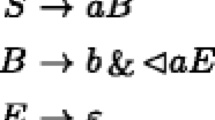Abstract
Contextual grammars were introduced by Marcus (Revue Roumaine de Mathematiques Pures et Appliquees 14:525–1534, 1969) based on the basic phenomenon in descriptive linguistics, that of acceptance of a word by a context or conversely. In this paper we present some results which are of interest for the potential application of contextual grammars to natural languages. We introduce some classes of internal contextual grammars, viz. maximum depth-first grammars, maximum lengthwise depth-first grammars, and absorbing right context grammars. The study of these classes is motivated by their potential linguistic relevance for natural languages. In particular, we analyze these variants with respect to the properties of mildly context-sensitive languages. With this aim, we first show that the three basic non-context-free constructions in natural languages can be realized upon using all such variants. Secondly, we state that the membership problem for the family of absorbing right context contextual languages is decidable by a polynomial time algorithm. Finally, we show that absorbing right context grammars produce semilinear languages only. Besides, we show that the non-marked duplication language can be generated by absorbing right context grammars, which is a unique feature not present in any other variant of contextual grammars.
Similar content being viewed by others
References
Bar-Hillel Y., Shamir E. (1964). Finite state languages: Formal representations and adequacy problems. In: Bar Hillel Y.(ed) Language and information. Reading, MA: Addison-Wesley, pp. 87–98
Boullier, P. (2000). Range concatenation grammars. In Proceedings of Sixth International Workshop on Parsing Technologies (IWPT 2000), pp. 53–64.
Boullier P. (2001). From contextual grammars to range concatenation grammars. Electronic Notes in Theoretical Computer Science 53, 1–12
Chomsky N. (1963). Formal properties of grammars. In: Luce RD et al. (eds) Handbook of mathematical psychology. New York, John Wiley, pp. 323–418
Ehrenfeucht, A., Ilie, L., Păun, Gh., Rozenberg, G., & Salomaa, A. (1995). On the generative capacity of certain classes of contextual grammars. In: Gh. Păun (Ed.), Mathematical linguistics and related topics (pp. 105–118). The Publ. House of the Romanian Academy.
Floyd R.W. (1962). On the non-existence of a phrase structure grammar for Algol-60. Communications of the ACM 5, 483–484
Ilie L. (1996). A non-semilinear language generated by an internal contextual grammar with finite selection. Annals of the Buchavest University, Mathematics-Information, Series, XIV(1): 63–70
Ilie L. (1997a). On computational complexity of contextual languages. Theoretical Computer Science 183(1): 33–44
Ilie, L. (1997b). Some recent results in contextual grammars. TUCS Technical Report No. 62.
Joshi, A. K. (1986). How much Context-Sensitivity is required to provide structural descriptions: Tree adjoining grammars. In D. Dowty, L. Karttunen, & A. Zwicky (Eds.), Natural language processing: Psycholinguistic, computational, and theoretical perspectives (pp. 206–250). Cambridge University Press.
Joshi A.K. (1988). An introduction to tree adjoining grammars. In: Manaster-Ramer A. (ed) Mathematics of language. Amsterdam, Philadelphia, John Benjamins, pp. 87–114
Krishna S.N., Lakshmanan K., Rama R. (2003). On some classes of contextual grammars. International Journal of Computer Mathematics 80(2): 151–164
Kudlek, M., Martin-Vide, C., & Mateescu, A. (1998). An infinite hierarchy of mildly context-sensitive families of languages. TUCS Technical Report No. 163.
Marcus S. (1967). Algebraic linguistics, analytical models. New York, Academic Press
Marcus S. (1969). Contextual grammars. Revue Roumaine de Mathematiques Pures et Appliquees 14, 1525–1534
Marcus, S., Martin-Vide, C., & Păun, Gh. (1996a). On internal contextual grammars with maximal use of selectors. In Proceedings of the 8th Conference Automata and Formal Languages, Salgotarjan.
Marcus, S., Martin-Vide, C., & Păun, Gh. (1996b). Contextual grammars versus natural languages. TUCS Technical Report No. 44.
Marcus S., Martin-Vide C., Păun Gh. (1998). Contextual grammars as generative models of natural languages. Computational Linguistics 24(2): 245–274
Martin-Vide, C., Miquel-Verges, J., & Păun, Gh. (1995). Contextual grammars with depth-first derivation. In Tenth Twente Workshop on Language Tech.; Algebraic Methods in Language Processing, Twente, pp. 225–233
Păun Gh. (1995). Marcus contextual grammars: After 25 years. Bulletin of EATCS 52: 183–194
Păun, Gh. (1997). Marcus contextual grammars. Kluwer Academic Publishers.
Păun Gh., Nguyen X.M. (1980). On the inner contextual grammars. Revue Roumaine de Mathematiques Pures et Appliquees 25: 641–651
Rozenberg G., Salomaa A. (eds) (1997). Handbook of formal languages, 3 volumes. Berlin, Springer-Verlag
Salomaa, A. (1973). Formal languages. Academic Press.
Author information
Authors and Affiliations
Corresponding author
About this article
Cite this article
Kuppusamy, L., Krishna, S.N., Raghavan, R. et al. Internal Contextual Grammars for Mildly Context-Sensitive Languages. Res on Lang and Comput 5, 181–197 (2007). https://doi.org/10.1007/s11168-007-9027-1
Received:
Accepted:
Published:
Issue Date:
DOI: https://doi.org/10.1007/s11168-007-9027-1




